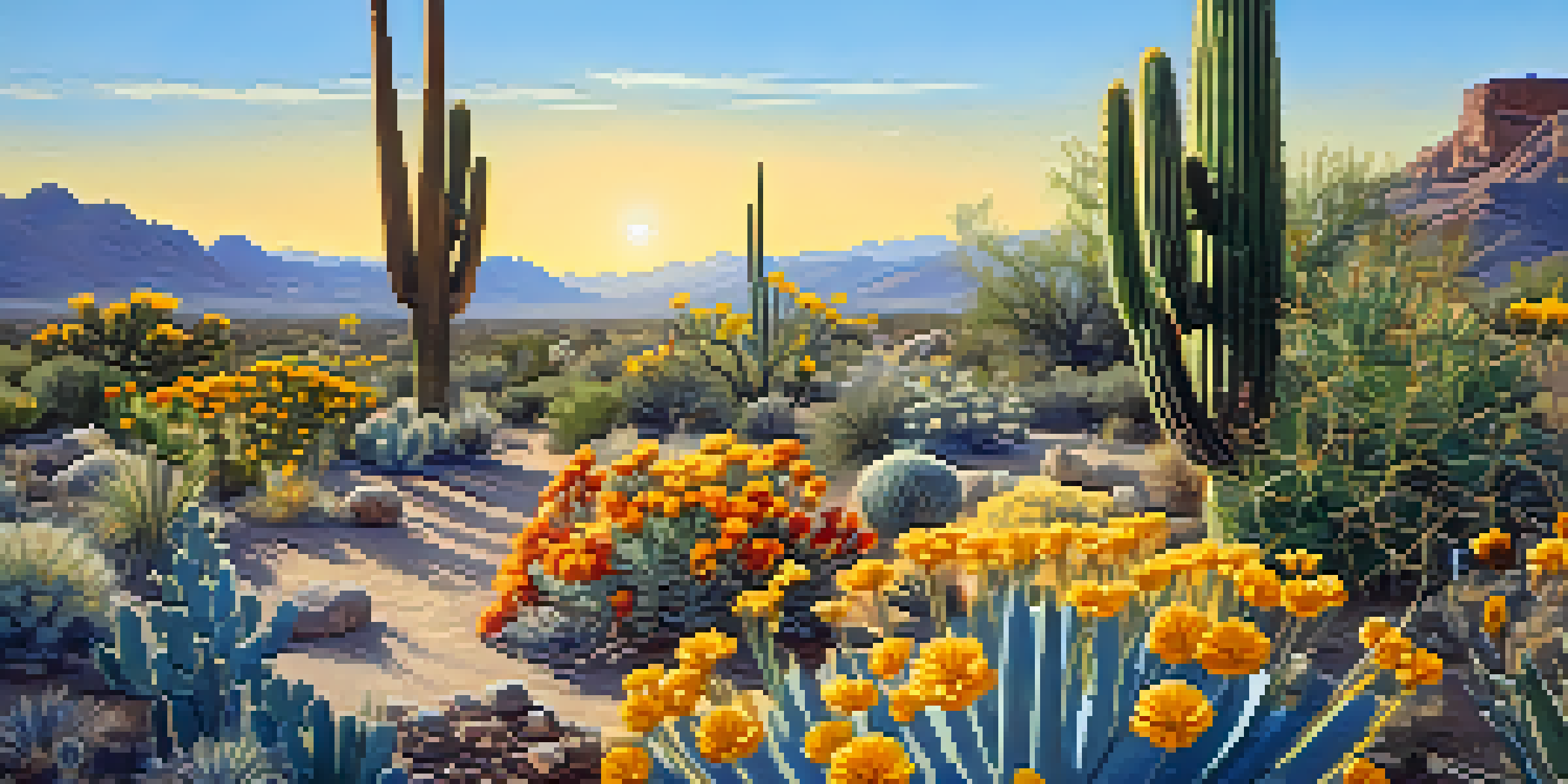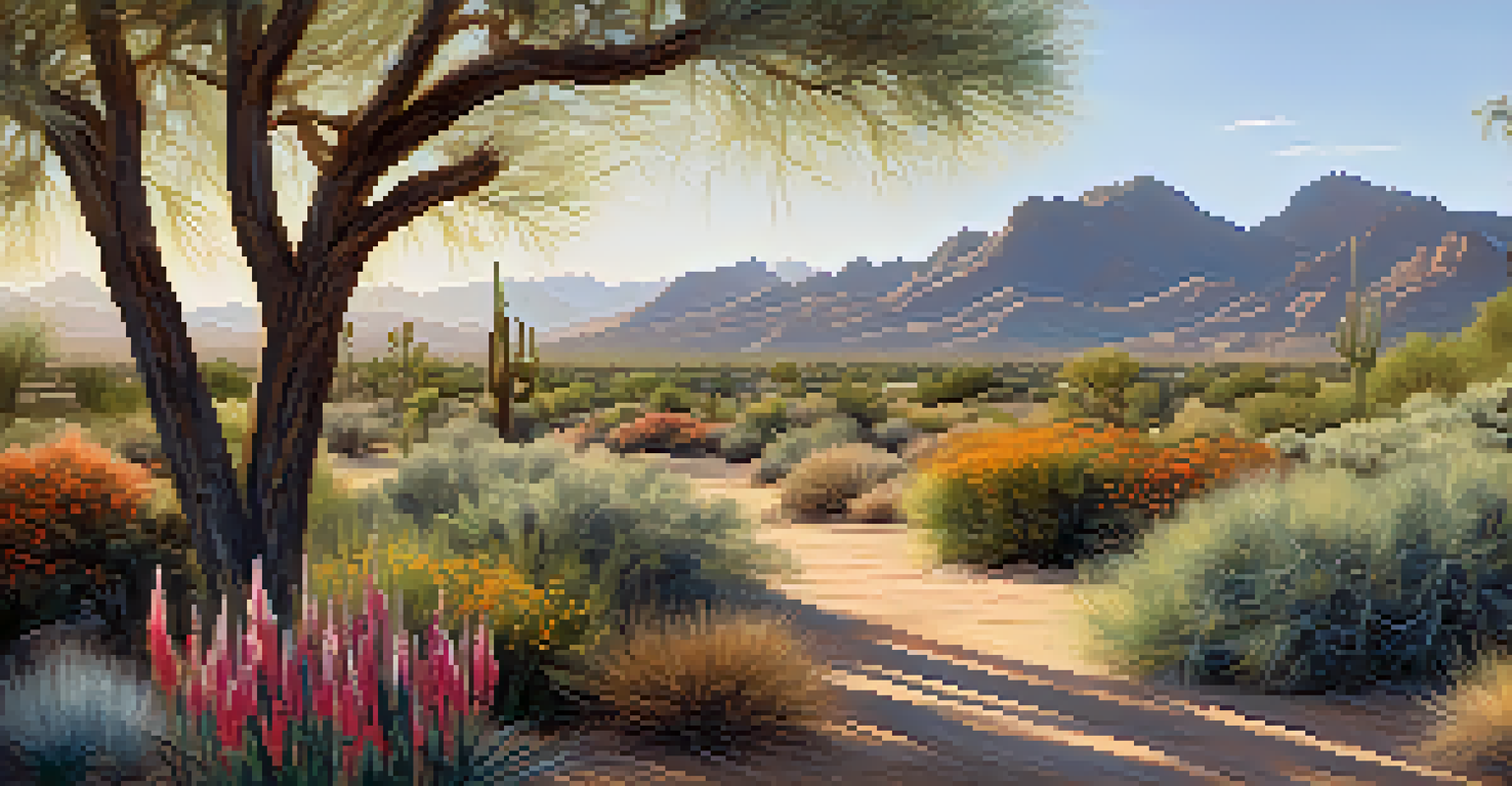The Importance of Native Plants in Scottsdale's Ecosystem

What Are Native Plants and Why Do They Matter?
Native plants are species that have naturally evolved in a specific region over thousands of years. They are perfectly adapted to the local climate, soil, and wildlife, making them incredibly resilient. Unlike non-native species, which can struggle to thrive in unfamiliar environments, native plants flourish, contributing to the stability of the ecosystem.
The future will be green, or not at all.
In Scottsdale, native plants include species like the Saguaro cactus and the Desert Marigold. These plants not only provide a habitat for local wildlife but also play a crucial role in maintaining soil health and preventing erosion. Their deep root systems help retain moisture, making them vital in our arid climate.
By choosing to plant native species in gardens and landscaping, residents can create a sustainable environment that supports local wildlife, including birds, butterflies, and beneficial insects. This practice not only enhances biodiversity but also fosters a deeper connection between the community and its natural surroundings.
The Ecological Benefits of Native Plants
Native plants contribute significantly to the health of local ecosystems. They provide food and shelter for a variety of animals, helping to sustain populations of local species. For instance, many birds rely on native plants for nesting materials and seeds, creating a balanced food web.

Moreover, these plants are adapted to the local climate and soil conditions, which means they require less water and maintenance compared to non-native species. This not only saves resources but also reduces the need for chemical fertilizers and pesticides, which can harm the environment.
Native Plants Enhance Ecosystems
Native plants are vital for supporting local wildlife and maintaining ecological balance.
Additionally, native plants play a key role in preserving biodiversity. By promoting a diverse range of plant species, we support the complex interactions between plants, animals, and microorganisms, which are essential for a resilient ecosystem. A rich biodiversity also protects against pests and diseases, ensuring a healthier environment for all.
How Native Plants Combat Climate Change
In the face of climate change, native plants serve as a natural solution for many environmental challenges. Their ability to absorb carbon dioxide helps mitigate the effects of greenhouse gases, contributing to cleaner air. This is particularly vital in urban areas like Scottsdale, where air quality can be compromised.
Nature does not hurry, yet everything is accomplished.
Additionally, native plants are more drought-resistant, which is increasingly important as water scarcity becomes a pressing issue. By using native species in landscaping, we can create green spaces that thrive with minimal water, reducing the overall demand for irrigation.
Furthermore, these plants can help regulate temperatures in urban environments, a phenomenon known as the 'urban heat island effect.' By providing shade and cooling the surrounding air, native plants create more comfortable and sustainable living conditions for residents.
Promoting Native Plants in Landscaping
Landscaping with native plants offers a wealth of benefits, both aesthetic and ecological. Homeowners can create beautiful gardens that require minimal upkeep by choosing plants suited to the local environment. This not only saves time and money but also enhances the visual appeal of the neighborhood.
Moreover, incorporating native plants into landscaping promotes wildlife habitat, inviting birds, butterflies, and other beneficial creatures into the area. A garden filled with native flora is much more than a pretty sight; it's a thriving ecosystem that supports local wildlife.
Combatting Climate Change Naturally
These plants help absorb carbon dioxide and are more drought-resistant, making them crucial in fighting climate change.
Community initiatives such as native plant sales and workshops can further educate residents about the advantages of using these plants in their gardens. By fostering a culture that values native species, Scottsdale can enhance its natural beauty while supporting ecological sustainability.
The Economic Value of Native Plants
Beyond their ecological benefits, native plants also offer significant economic advantages. Landscaping with native species can reduce maintenance costs for homeowners and municipalities alike. Since these plants require less water and fewer resources, they can lead to substantial savings over time.
Additionally, native plant nurseries and landscaping services focused on these species can stimulate local economies. By supporting businesses that specialize in native plants, communities can generate jobs and promote sustainable practices that align with environmental goals.
Tourism can also benefit from Scottsdale's commitment to preserving its native flora. Eco-tourism, focused on natural landscapes and wildlife, attracts visitors eager to experience the beauty and uniqueness of the region's ecosystem, providing a boost to the local economy.
Native Plants and Community Engagement
Engaging the community in the promotion and preservation of native plants can create a sense of stewardship and connection to the local environment. Educational programs and volunteer opportunities, such as native planting days, allow residents to actively participate in enhancing their surroundings.
These initiatives not only foster a greater appreciation for local ecosystems but also encourage interaction among community members. People come together to learn, share experiences, and work towards a common goal of sustainability and environmental health.
Economic Benefits of Native Landscaping
Landscaping with native species reduces maintenance costs and stimulates local economies through eco-tourism and sustainable practices.
Moreover, when communities prioritize native plants, they set an example for future generations. Teaching children about the importance of local flora and fauna instills a sense of responsibility towards the environment, ensuring that the values of conservation continue to thrive.
Conclusion: Embracing Native Plants for a Sustainable Future
In conclusion, native plants are not just a beautiful addition to Scottsdale's landscape; they are essential to the health of the local ecosystem. By supporting biodiversity, combating climate change, and promoting community engagement, these plants play a crucial role in creating a sustainable future for the region.
As residents of Scottsdale, embracing native plants can lead to a more resilient environment that benefits not only wildlife but also the community. Simple changes, like choosing native species for gardens, can have a lasting impact on the local ecosystem.

By understanding the importance of native plants and taking action to support them, we can create a thriving, sustainable Scottsdale that honors its unique ecological heritage for generations to come.